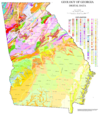IntroductionThe Triassic (/traɪˈæsɪk/ try-ASS-ik; sometimes symbolized 🝈) is a geologic period and system which spans 50.5 million years from the end of the Permian Period 251.902 million years ago (Mya), to the beginning of the Jurassic Period 201.4 Mya. The Triassic is the first and shortest period of the Mesozoic Era. Both the start and end of the period are marked by major extinction events. The Triassic Period is subdivided into three epochs: Early Triassic, Middle Triassic and Late Triassic. The Triassic began in the wake of the Permian–Triassic extinction event, which left the Earth's biosphere impoverished; it was well into the middle of the Triassic before life recovered its former diversity. Three categories of organisms can be distinguished in the Triassic record: survivors from the extinction event, new groups that flourished briefly, and other new groups that went on to dominate the Mesozoic Era. Reptiles, especially archosaurs, were the chief terrestrial vertebrates during this time. A specialized group of archosaurs, called dinosaurs, first appeared in the Late Triassic but did not become dominant until the succeeding Jurassic Period. Archosaurs that became dominant in this period were primarily pseudosuchians, relatives and ancestors of modern crocodilians, while some archosaurs specialized in flight, the first time among vertebrates, becoming the pterosaurs. Therapsids, the dominant vertebrates of the preceding Permian period, declined throughout the period. The first true mammals, themselves a specialized subgroup of therapsids, also evolved during this period. The vast supercontinent of Pangaea dominated the globe during the Triassic, but in the latest Triassic (Rhaetian) and Early Jurassic it began to gradually rift into two separate landmasses: Laurasia to the north and Gondwana to the south. The global climate during the Triassic was mostly hot and dry, with deserts spanning much of Pangaea's interior. However, the climate shifted and became more humid as Pangaea began to drift apart. The end of the period was marked by yet another major mass extinction, the Triassic–Jurassic extinction event, that wiped out many groups, including most pseudosuchians, and allowed dinosaurs to assume dominance in the Jurassic. (Full article...) Selected article on the Triassic world and its legacies
The annelids are a large phylum of segmented worms, with over 2,000 modern species including ragworms, earthworms and leeches. They are found in marine environments from tidal zones to hydrothermal vents, in freshwater, and in moist terrestrial environments. The basic annelid form consists of multiple segments, each of which has the same sets of organs and, in most polychaetes, a pair of parapodia that many species use for locomotion. Septa separate the segments of many species, but are poorly defined or absent in some. Septa also enable annelids to change the shapes of individual segments, which facilitates movement by "ripples" that pass along the body or by undulations. Although many species can reproduce asexually and use similar mechanisms to regenerate after severe injuries, sexual reproduction is the normal method in species whose reproduction has been studied.
Since annelids are soft-bodied, their fossils are rare – mostly jaws and the mineralized tubes that some of the species secreted. Although some late Ediacaran fossils may represent annelids, the oldest known fossil that is identified with confidence comes from about 518 million years ago in the early Cambrian period. Fossils of most modern mobile polychaete groups appeared by the end of the Carboniferous, about 299 million years ago. Scientists disagree about whether some body fossils from the mid Ordovician, about 472 to 461 million years ago, are the remains of oligochaetes, and the earliest certain fossils of the group appear in the Tertiary period, which began 65 million years ago. (see more...) Did you know?
Need help?Do you have a question about Abyssal/Portal:Triassic that you can't find the answer to? Consider asking it at the Wikipedia reference desk. Selected image
Selected article on the Triassic in human science, culture and economics
The geologic map of Georgia (a state within the United States) is a special-purpose map made to show geological features. Rock units or geologic strata are shown by colors or symbols to indicate where they are exposed at the surface. Structural features such as faults and shear zones are also shown. Since the first national geological map, in 1809, there have been numerous maps which included the geology of Georgia. The first Georgia specific geologic map was created in 1825. The most recent state-produced geologic map of Georgia, by the Georgia Department of Natural Resources is 1:500,000 scale, and was created in 1976 by the department's Georgia Geological Survey. It was generated from a base map produced by the United States Geological Survey. The state geologist and Director of the Geological Survey of Georgia was Sam M. Pickering, Jr. Since 1976, several geological maps of Georgia, featuring the state's five distinct geologic regions, have been produced by the federal government. (see more...)
GeochronologyEpochs - Early Triassic - Middle Triassic - Late Triassic Landmasses - Baltica - Gondwana - Laurentia - Siberia Fossil sites - Beecher's Trilobite Bed - Walcott–Rust quarry Researchers - Charles Emerson Beecher - Charles Lapworth - Charles Doolittle Walcott Quality ContentFeatured Mesozoic articles - Bone Sharps, Cowboys, and Thunder Lizards - Bone Wars - Edward Drinker Cope - Geology of the Capitol Reef area - Geology of the Death Valley area -Geology of the Grand Canyon area - Geology of the Zion and Kolob canyons area Good Mesozoic articles - Chitinozoan - Coal ball - Dimetrodon - History of paleontology - Evolutionary history of life - Ornatifilum - Opabinia - Paleontology- Schinderhannes - Small shelly fauna - Temnospondyli - Tiktaalik - Waptia SubcategoriesRelated contentAssociated WikimediaThe following Wikimedia Foundation sister projects provide more on this subject:
|




















